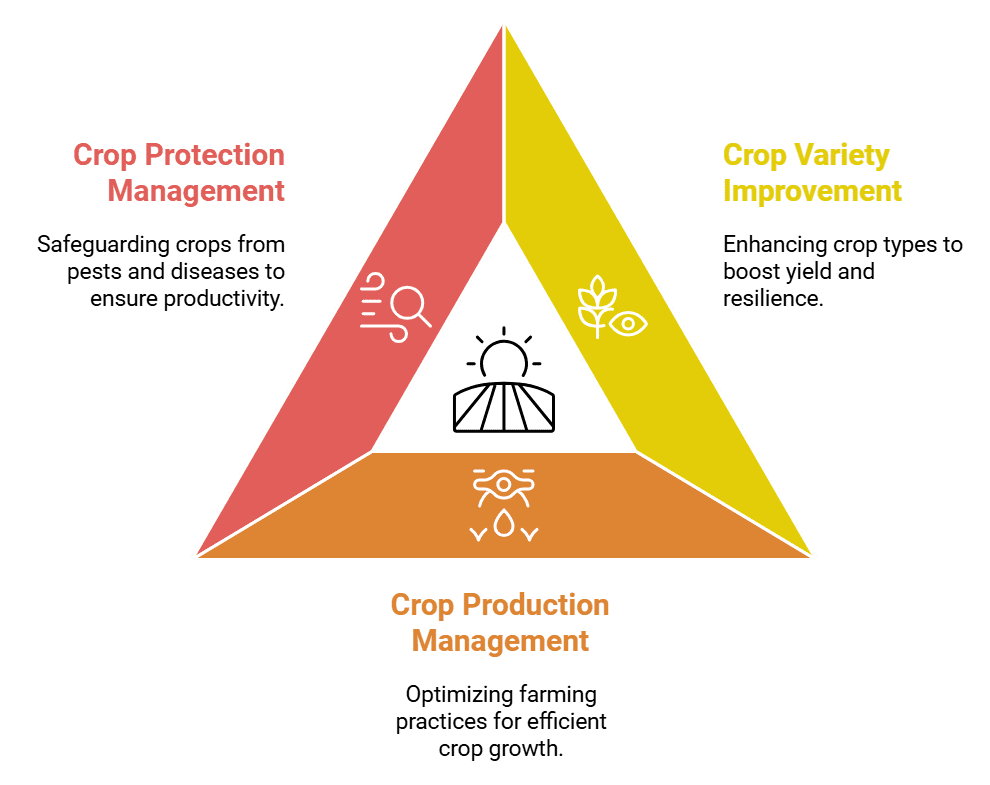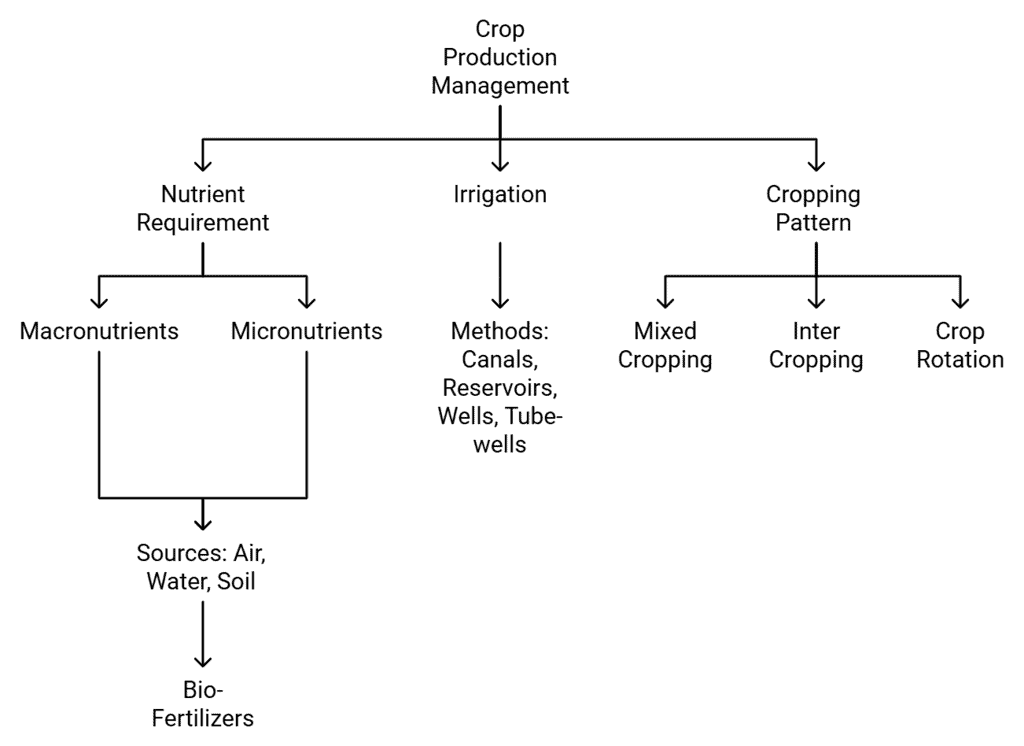Introduction - Improvement in Food Resources | Science Class 9 PDF Download
| Table of contents |

|
| Different Types of Crops |

|
| Crop Variety Improvement |

|
| Crop Production Management |

|
| Crop Protection Management |

|
| Organic Farming |

|
All living organisms require food for their growth and survival. The food supplies carbohydrates, proteins, fats, vitamins, and minerals. The two major sources of food are the plants and animals which are obtained from agriculture and animal husbandry.

- In the present time due to the tremendous increase of human population, the demand for food and shelter are also increased.
- Higher grain output can be achieved by bringing more land under cultivation. The other possibility is to increase production efficiency of both plants and animals. Increase in production can be brought about by the development and use of improved varieties with high yield and better managerial practices (both pre and post-harvest).
- It is important that food production should be increased without degrading our environment and disturbing the natural balance. This is possible through genetic improvement of crop plants (a second green revolution) domesticated animals adopting sustainable agriculture and animal husbandry.
Different Types of Crops
 Types of Crop
Types of Crop
A. On the basis of Nutrients they provide
(i) Cereals: These are rich in carbohydrates and thus provide energy.
Example: Rice, wheat, maize, sorghum, barley, millets.
(ii) Pulses: These are rich in protein and thus helpful for bodybuilding.
Example: Gram, moong, pea, lentil, and, pigeon pea.
(iii) Oilseed Crops: These are rich in oil and fatty acids.
Example: Groundnut, sunflower, soya bean, mustard, sesame.
(iv) Vegetable Crops: These provide vitamins, minerals along with small quantities of carbohydrates, protein and oils.
- Leaves: Cabbage, spinach, Trigonella, lettuce
- Roots: Carrot, radish, turnip, sweet potato
- Stems: Potato, corms, rhizomes (ginger)
- Bulbs: Onion, garlic
- Fruits: Tomato, brinjal, gourd, cucumber
- Flowers: Cauliflower, Bauhinia, banana
(v) Spices: They are used for enhancing palatability.
Example: Chilly, black pepper, ginger, turmeric.
(vi) Fodder Crops: These provide green fodder to the cattle.
Example: Berseem, sorghum, maize, oat, sudangrass, alfalfa.
B. On the basis of season in which they are grown
(i) Kharif crop: Grown in rainy season (from June to October)Example: Paddy, Soya bean, Arhar, Maize, Cotton, Urad, Moong etc.
(ii) Rabi crop: grown in summer season (November to April)
Example: Wheat, Gram, Peas, Mustard, Linseed
They are also called “summer season crop”.
To obtain higher yield from farmland following three systems are being used

Crop Variety Improvement
The first and foremost important step to improve the crop yield is to improve the variety of crop which has following characteristics i.e. crop variety improvement is done for the following purposes:- Higher yield.
- Better quality.
- Biotic & abiotic resistance i.e. disease, insects & pest resistance.
- Desirable agronomic characters for specific crops like dwarfness, intensive branching, more tillering & increased fertiliser responsiveness.
- Wider adaptability: developed improved crops help in stabilizing crop production under different climatic conditions.
- Early maturation(ripening)
- Better response to fertilisers.
Crop variety can be improved by plant breeding. Plant breeding can be done either by selection or hybridisation
Crop Production Management
 Crop Production Mangement
Crop Production Mangement
(i) Nutrient Requirement
There are two types of nutrients required by the plants- (a) Macronutrients: needed by the plants in large amount. E.g.- N2, P, K, Ca, Mg, S
- (b) Micronutrients: needed by the plants in very small amount.e.g. - Fe, Cu, Zn, Bo, Mo, Cl.
Sources of plant nutrients:
- Air: Carbon, Oxygen
- Water: Hydrogen
- Soil: N2, P, K, Ca, Mg, S, Fe, Mn, Bo, Zn, Co, Mo, Cl
“Most important nutrients needed for growth of plants are N2, P, and K”
Bio-Fertilisers: Living beings used to increase the soil fertility are called bio-fertilisers.
Example: Anabaena, Nostoc, Rhizobium, Blue-green algae, Azollaetc etc.
 |
Download the notes
Introduction - Improvement in Food Resources
|
Download as PDF |
(ii) Irrigation
The technique of providing water to the crops in the fields by means of Canals, Reservoir, Wells and Tube-wells etc is called irrigation.
(iii) Cropping Pattern
Following ways of growing crops can be used to give maximum benefits:
1. Mixed cropping
2. Inter cropping
3. Crop rotation
Crop Protection Management
It includes protection of the growing crops and harvested crops. Weeds, insects, pests and diseases infest the field crops. It can be controlled by adopting following methods:-
- To grow resistant verities.
- Optimum time of sowing the crops.
- Crop rotation and cropping systems.
- Deep ploughing in summers to kill weeds, pathogen etc. i.e. summer ploughing.
Organic Farming
Organic farming avoids the use of synthetically compound fertilizers, pesticides. Organic farming rely upon crop rotation, crop residues, animal manures, legumes, green manures, off farm organic wastes, biological pest control.|
84 videos|384 docs|61 tests
|
FAQs on Introduction - Improvement in Food Resources - Science Class 9
| 1. What are the different types of crops? |  |
| 2. How does crop variety improvement benefit agriculture? |  |
| 3. What is crop production management? |  |
| 4. What are the key practices in crop protection management? |  |
| 5. What are the principles of organic farming? |  |























